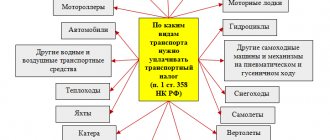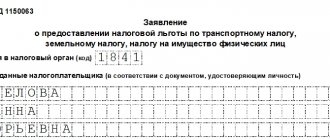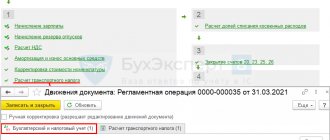Transport tax (TN) is a tax designed to compensate for the harmful effects of vehicles on road surfaces and the environment. It is regulated both by Chapter 28 of the Tax Code of the Russian Federation (for federal calculations) and by legislative acts adopted in each individual region (for regional calculations). Legislative acts adopted by regions affect the tax rate, the procedure and terms of payment, and so on.
Let's take a closer look at the information on tax rates for road transport that will be in effect in 2022.
Basics of vehicle tax calculation
Chapter is devoted to transport tax.
28 Tax Code of the Russian Federation. It defines transport tax payers as persons (legal entities and individuals) to whom vehicles are registered. The determining factor in this case is the fact of registration, and not the right of ownership. So, for example, a company can lease a car, and for the period of validity of the leasing agreement this car will be registered in its name, although the lessor will remain the owner. Read about transport tax for leasing here.
Vehicles and mechanisms, both self-propelled and towed, are subject to transport tax. The vast majority of them are cars. At the same time, some types of cars are exempt from taxation (clause 2 of Article 358 of the Tax Code of the Russian Federation):
- passenger cars equipped for disabled people;
- passenger cars with power up to 100 hp. pp. acquired through social security authorities;
- agricultural machines registered to agricultural producers and used by them for their intended purpose;
- vehicles of federal military services;
- are on the wanted list, and the fact of the search must be documented by the relevant authorities.
The tax base for transport tax for a car is the horsepower of its engine. The base rates are set by Ch. 28 Tax Code of the Russian Federation.
For individual water and air vehicles, other indicators are used as the tax base for transport tax (gross tonnage, static thrust of a jet engine, etc.).
Find out more about this in the material “How is the tax base for transport tax determined?”
Transport tax is calculated separately for each car by multiplying its power by the rate applicable to this type of car. If the car was registered or deregistered in the accounting year (i.e., was registered with the taxpayer for less than a full year), then the calculation applies a coefficient that reduces the tax in proportion to the share of months of ownership of the vehicle during the year. In this case, the month in which the car was purchased before the 15th or was disposed of after the 15th is considered complete (clause 3 of Article 362 of the Tax Code of the Russian Federation).
To learn whether it is necessary to charge tax on vehicles registered and deregistered on the same day, read the article “How to pay transport tax if a vehicle is registered and deregistered on the same day?” .
Transport tax, the basic rules of which are established by the Tax Code of the Russian Federation, is a regional tax. It is put into effect by the laws of the constituent entities of the Russian Federation, which have the right to make the following changes to the rules established by the Tax Code:
- Transport tax rates can be changed both upward and downward (with a deviation of no more than 10 times from the base), while the reduction restriction does not apply to passenger cars with an engine power of up to 150 hp. With. inclusive;
- your own system of tax benefits may be introduced;
- Your own procedure and deadlines for tax payment may be established.
This circumstance makes it important for the taxpayer not only to study the text of Chapter. 28 of the Tax Code of the Russian Federation, but also knowledge of the current law on transport tax of the region where the transport is registered.
Organizations calculate the transport tax payable independently based on the data they have, and for the transport of individuals, the calculation is made by the Federal Tax Service.
Tax payments by organizations can be made either once a year based on the results of the declaration, or by transferring advance payments (if they are provided for by a constituent entity of the Russian Federation). Individuals pay tax once for the past year.
Read about tax payment deadlines here.
Find out what BCCs for transport tax are in 2022 - 2022 for organizations .
Read more about rising fuel costs
The injustice of the current system by which transport tax is calculated in Russia in 2022 (for 2022) is obvious and is easily demonstrated by example.
Example:
- An elderly retired family took out an SUV on credit for trips to the dacha during the season. The average number of trips per year does not exceed 10, while the amount of the annual amount paid under the transport tax is equal to the amount paid by the head of a company with a multimillion-dollar salary who purchased a similar car as a status one.
At the same time, we must not forget that transport tax in Russia in 2019 must be paid according to the old scheme, that is, it is not yet included in the price of gasoline.
At the same time, the rise in gasoline prices has not stopped since the first months of 2022. In fact, every motorist pays double the basic tax and the excise tax on gasoline. Currently, owners of vehicles with a capacity of 200 to 300 hp. With. They pay about 714 rubles per year per unit of power, the transport tax in Russia in 2022 will be about 743 rubles, and a year later it will increase to 773 rubles. The amount to be paid is valid even if the car is faulty and not in use.
Some functionaries, in an attempt to attract supporters, are trying to lobby for the abolition of the transport tax. But this populist rhetoric remains unnoticed by office colleagues, since the transport tax in Russia in 2022 is planned to bring more than 150 billion rubles to the treasury. Also, opponents of the abolition draw attention to the fact that today the debt of Russians to the budget for transport tax has exceeded 2 trillion rubles. The loss of existing income is unacceptable for the treasury in the current economic conditions.
In addition to the proposal to abolish the transport tax in Russia in 2019, the Duma members brought up for hearings projects to replace fuel charges with additional fuel duties, and proposed linking calculations to engine size and the degree of environmental damage. The largest number of supporters was found in the project proposing the replacement of the TN with a so-called environmental tax, calculated based on the level of pollution of the vehicle.
The question of whether the transport tax in Russia will be replaced by an environmental tax in 2022 remains open. Chairman of the State Duma E. Moskvichev states that the finished bill on the introduction of an “environmental tax” will be submitted for consideration at the beginning of 2019. There is a high probability of unanimous approval of the project after its study by the Duma members. The details of the project are unknown to the general public.
If the transport tax in Russia is replaced by an environmental tax in 2022, owning old cars that do not meet the latest EURO environmental standards will simply become unprofitable. At the same time, there is a high probability that vehicles with Euro 4.5 and 6 engines will be classified as preferential.
The majority of Russians with below-average incomes have at their disposal old domestic or foreign cars that are far from meeting Euro standards. If the tax is added to the cost of fuel, companies and individuals who use energy-intensive vehicles for work will suffer the most.
How does the Federal Tax Service determine the amount of road tax?
Data on the registration and deregistration of vehicles with the Federal Tax Service comes from the State Traffic Safety Inspectorate. They serve as a source of information for the tax inspectorate for checking data on declarations prepared by organizations and for calculating tax on vehicles registered to individuals. In relation to the transport tax calculated taking into account the characteristics of the region, notifications are sent to individuals about its payment.
ATTENTION! Starting with the tax for 2022, legal entities will also receive a tax message with the calculated amount. And they will stop submitting tax return declarations to the Federal Tax Service. However, this does not mean that they will no longer need to calculate tax. This responsibility will remain with organizations in the future. After all, they must know the amount in order to make advance payments throughout the year (if such are established in the region). And the message from the tax office is more of an informational nature, so that the company can compare its accruals with those made according to the tax authorities. And she will receive it after the deadline for paying advances (see, for example, letter of the Ministry of Finance dated June 19, 2019 No. 03-05-05-02/44672).
Cost of car tax: how much does it cost to maintain an expensive car?
Owners of expensive cars (with an average cost of 3,000,000 rubles) will have to pay transport tax taking into account an increasing coefficient, the value of which (from 1.1 to 3.0) is determined in accordance with clause 2 of Art. 362 of the Tax Code of the Russian Federation, depending on the average cost of the car and the year of its manufacture. The list of such cars is published annually by the Ministry of Industry and Trade.
Is there an increasing factor for your car? Read the article “How to calculate the age of an expensive car to apply an increasing factor for transport tax .
From 2022, for cars costing from 3 million to 5 million rubles. no older than 3 years, a single coefficient of 1.1 is applied.
Read more about the increasing coefficient here.
Increasing transport tax coefficient in 2021–2022
The increasing coefficient for transport tax should be taken into account when calculating not only the amount of tax for the year, but also advances for it (clause 2.1 of Article 362 of the Tax Code of the Russian Federation).
For more information on the procedure for calculating transport tax, read the article “How to calculate transport tax on a car?” .
If an expensive car is registered to your company, before calculating the transport tax, check:
- Is your car included in the list posted on the website of the Ministry of Industry and Trade? Use only the current list (it is updated annually).
- Does the period of use of the car exceed the period established in the Tax Code of the Russian Federation for the purposes of applying the increasing coefficient? When calculating the period, it is necessary to start with the year the car was launched from the assembly line and end with the year for which the tax is paid (letter of the Federal Tax Service of Russia dated March 2, 2015 No. BS-4-11 / [email protected] ).
If at least one of the conditions is not met, the increasing factor is not applied.
To find out whether an increasing coefficient is applied to the tax if the car is not listed in the list published by the Ministry of Industry and Trade, read the material “How to pay transport tax if an expensive car is not on the list of the Ministry of Industry and Trade?” .
If the conditions are met, when calculating transport tax on a passenger car with an average cost of more than 3 million rubles. you need to apply the formula:
TN = TPop × Kp,
where TPop is the amount of transport tax calculated according to the general rules (the product of the tax base by the tax rate and the vehicle ownership coefficient);
Kp - increasing coefficient.
EXPLANATIONS from ConsultantPlus: To determine the period for applying the increasing coefficient, the year of manufacture of the car is important. The List indicates: the number of years that have passed since the year of issue. For example, “2 years”. In this case, the increasing factor must be applied in relation to... Get trial demo access to the K+ system and switch to the Ready-made solution for free.
It is also necessary to pay tax taking into account the increasing coefficient in cases where the description of the model (version) for the corresponding brand of passenger car in the list of the Ministry of Industry and Trade contains less or more information compared to information from the State Traffic Safety Inspectorate (letter of the Federal Tax Service dated July 18, 2017 No. BS-4-21 / [email protected] ).
Transport tax - 2019–2020: tariffs
Vehicle tax rates for 2019–2020 vary by region. Rates may change from year to year, so it is worth following regional legislation regarding transport tax.
Table of transport tax rates by region for 2019-2020. you will find here.
Vehicle tax in 2019–2020 is calculated according to the same rules that were in force previously (more precisely, since 2016). Special tax benefits in comparison with the Tax Code of the Russian Federation are available only in Moscow (Moscow Law No. 33 dated July 9, 2008) and the Moscow Region (Moscow Region Law No. 129/2002-OZ dated November 16, 2002).
Transport tax on heavy trucks
Until January 1, 2022, in the case of payment to Plato in relation to a vehicle with a permissible maximum weight of over 12 tons, the organization did not pay advance payments for transport tax.
This was provided for in paragraph 2 of paragraph 2 of Article 363 of the Tax Code of the Russian Federation. In addition, the organization reduced the transport tax at the end of the year by the amount paid to Plato for the corresponding tax period. If, in the event of a reduction in transport tax by payment to Plato, the amount of tax payable to the budget took a negative value, then the transport tax was not paid. But, according to paragraph 4 of Article 2 of the Federal Law of July 3, 2016 N 249-FZ, this procedure was in effect until December 31, 2018. In this connection, from January 1, 2019, such organizations pay transport tax in the general manner, that is, pay advance payments, unless otherwise established by the laws of the constituent entities of the Russian Federation, and the tax itself.
What has changed in the transport tax in recent years?
Perhaps the most significant recent change in transport tax for legal entities was the abolition of its declaration. We report for the last time for 2022.
In addition, the following innovations have been introduced in recent years:
- from July 2016, the possibility of applying in 2016–2018 to the tax accrued on heavy vehicles a deduction (up to a zero tax value) in the amount of payment paid for the corresponding year for damage caused to roads by this transport (clause 2 of Article 362 of the Tax Code RF);
- from 2022, simplification for individual payers: they are not required to document the benefits for transport tax, they just need to submit an application, and the tax authorities will ask for confirmation from the competent authority themselves (and only if they are not answered to the request, they will ask for documents from the “physicist”) ;
- from 2022 - new tax obligations for legal entities, related specifically to the cancellation of declarations;
- from 2022 - new rules and deadlines for tax payment by organizations.
Results
Payers of transport tax are legal entities and individuals to whom vehicles are registered. The tax base for transport tax for a car is the horsepower of its engine. Tax rates are established in the Tax Code of the Russian Federation and can be adjusted by regional laws. In recent years, various changes have been made to the transport tax, the key of which is the abolition of tax returns for legal entities.
Sources: Tax Code of the Russian Federation
You can find more complete information on the topic in ConsultantPlus. Free trial access to the system for 2 days.







